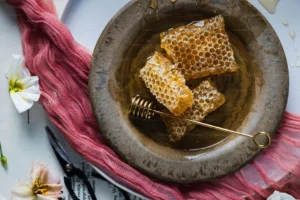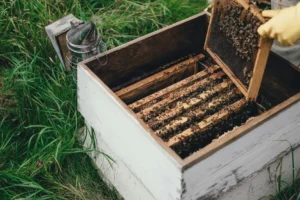Table of Contents
Honey is a versatile and delicious ingredient that adds a unique flavor and sweetness to a variety of dishes. However, there may be times when you run out of honey or prefer not to buy it due to its price. In such situations, you can use simple kitchen ingredients to create a honey substitute that is just as good. This article will guide you through the process of making a sugar-based honey substitute and explore other alternatives you can try.
Making a Sugar-Based Honey Substitute
To create a honey substitute using sugar, you will need two basic ingredients: granulated sugar and water. Follow these simple steps to make your own honey substitute:
- In a pot, combine 1 1/4 cups of granulated sugar and 1/4 cup of water.
- Heat the mixture over medium heat, stirring constantly, until the sugar dissolves completely into the water.
- Once the sugar has dissolved, replace the honey called for in your recipe with an equal amount of the honey substitute.
- The resulting mixture should have a similar thickness to honey, ensuring that your recipe remains unchanged.
This recipe yields 1/4 cup (or 4 tablespoons) of honey substitute. If you need a different quantity, you can adjust the measurements accordingly. Here’s a handy guide:
- 1 tablespoon = 1 tablespoon water + 1/4 cup sugar + 1 tablespoon sugar
- 2 tablespoons = 1/8 cup water + 1/2 cup sugar + 2 tablespoons sugar
- 1/2 cup = 1/2 cup water + 2 1/2 cups sugar
- 3/4 cup = 3/4 cup water + 3 3/4 cups sugar
- 1 cup = 1 cup water + 5 cups sugar
By maintaining a 5:1 ratio of sugar to water, you can easily adjust the quantity of the honey substitute according to your needs.
Sugar-Free Honey Substitute
For individuals watching their sugar intake, you can replace the granulated sugar in the recipe with a sugar replacement that measures the same as sugar. This allows you to enjoy a sugar-free honey substitute without compromising the taste of your dish.
Exploring Other Honey Substitutes
If you find yourself low on granulated sugar or prefer alternatives to a sugar-based honey substitute, there are several options you can try. These substitutes can be used in a measure-for-measure replacement of honey in your recipes. While they may slightly alter the flavor, it can be a delightful change. Some alternatives to consider include:
1. Corn Syrup
Corn syrup, whether light or dark, can be used as a substitute for honey. It matches the thickness and sweetness of honey, making it an ideal choice for various recipes.
2. Golden Syrup
Golden syrup is a thick, amber-colored syrup with a similar consistency to honey. It offers a distinct flavor and can be an excellent substitute for honey in both texture and taste.
3. Maple Syrup
Maple syrup is a popular and widely available alternative to honey. Its sweet and rich flavor pairs well with many dishes, making it a suitable replacement in recipes that call for honey.
4. Molasses
Molasses, excluding blackstrap molasses, can be used in place of honey. It has a robust flavor that can add depth to your recipe. Be mindful of the taste profile when substituting molasses for honey, as it may alter the overall flavor of your dish.
It’s important to note that these alternatives may change the flavor of your recipe slightly, but sometimes that can be a pleasant surprise. Experiment with different substitutes to find the one that best suits your taste preferences.
Reviving Crystallized Honey
If you have honey that appears cloudy or has crystallized, it does not mean it has gone bad. Crystallization is a natural process in which the sugars in honey solidify. To restore your honey to its original state, follow these steps:
- Remove the lid from the honey jar and place it in a pot of water.
- Heat the pot over low heat, allowing the water to gently warm the honey.
- Stir the honey occasionally until the sugar dissolves back into the honey, restoring its smooth consistency.
It’s essential to transfer honey from a plastic container to a heat-safe container before heating it. This precaution prevents any potential damage or melting of the plastic due to heat exposure.
While honey does not spoil, excessive water content can cause fermentation. If you notice bubbling, a bulging lid, or a change in taste, it may indicate that your honey has fermented. In this case, it is safe to consume if you enjoy the taste and are comfortable with the alcohol content. However, storing fermented honey in a glass jar can be dangerous due to the buildup of carbon dioxide, which can cause the jar to explode. To avoid any potential hazards, transfer the honey to a plastic container for safe storage.
Choosing the Right Substitute
When considering a honey substitute, it’s important to understand which alternatives work best in specific recipes. Sugar-based substitutes generally work well in baked goods, ensuring the desired texture and sweetness. However, for sauces, glazes, or marinades, maple syrup can be an excellent replacement, even if it introduces a slight flavor variation. Keep in mind that recipes specifically named after honey may require the distinct flavor of honey, so a substitute may not be suitable.
For example, using a substitute in a honey mustard dressing might not yield the desired result. On the other hand, replacing honey with maple syrup in a honey-glazed carrot recipe should result in a delicious dish. Consider the flavor profile of your recipe and how a substitute might complement or alter it.
In conclusion, when you find yourself in need of a honey substitute, you can easily create one using sugar and water. However, if you prefer different alternatives, corn syrup, golden syrup, maple syrup, or molasses can also be used. Each substitute offers its own unique flavor and texture, allowing you to experiment and find the perfect replacement for your dish. Remember to adjust the quantity and consider the original recipe’s flavor profile to ensure the best results. Enjoy exploring the world of honey substitutes and discover new flavors in your culinary creations.



